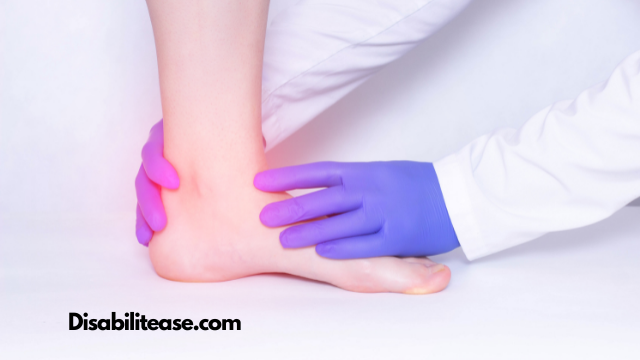What cause gouty arthritis? Gout is a common subtype of arthritis characterized by painful inflammation and marked tenderness. It is one of the most occurring diseases throughout the world.
Gout is usually accompanied by inconsistent pain, tenderness, and joint swelling with distinct periods of flare-ups and remissions.

It typically affects the big toe but can also affect other joints such as the hand, wrists, knees, or ankles. The condition usually develops due to accumulation of uric acid crystals within the joints.
Here is a related article that might interest you on What Is Bacterial Arthritis?
Uric acid is produced when the body breaks down the food we consume. Some individuals experience an abnormality in handling this byproduct, leading to crystallization and buildup.
This crystallization, in turn, causes excessive inflammation and makes the movement of affected joints difficult. However, not every case of excessive uric acid production leads to gout. The condition becomes more likely when the body has a problem removing this production.
In advanced stages, the high levels of serum urate accumulation can lead to the development of needle-like crystals causing painful inflammation and effortful movement.
While there are no permanent cures for the condition, it is highly manageable, and symptoms can be minimized with medication.
Table of Contents
Common Symptoms of Gouty Arthritis
Pain
One of the most common symptoms includes sudden flare-ups of pain within the affected joints. The pain can become more evident after prolonged periods of activity or strain on the body. It is typically present inconsistently and may become hyperactive for a week and then subside for the following week.
The symptom also accompanies stiffness, redness, and a warm sensation near the affected area.
Swelling
The swelling usually remains persistently even without any pain or stiffness. It happens due to the inflammation caused by excessive uric acid buildup. It is often accompanied by tenderness within surrounding muscles that are sensitive to mild to moderate pressure.
Reduced Motion
The combination of all present symptoms can lead to effortful and painful motion. Affected individuals often feel a severe, sharp pain as they try to engage the affected joint.
Sudden Triggers
Gout-related pain can suddenly flare up after consumption of certain foods or medication. Alcohol and other underlying illnesses can also give rise to unexplained inflammation and tenderness.
Tophus
This is more common in the advanced stages and may be prevented with early treatment. Tophus is a form of hard lumps that develop around the impacted joints. They are typically painless and do not result in discomfort during movement in the early stages.
However, over time, they become noticeably painful and can cause damage to the surrounding tissues along with joint deformity.
Diagnosing Gouty Arthritis
Gout is relatively straightforward to diagnose and can be detected with a few tests. After assessing for the possibility of gout, your doctor may forward your case to a rheumatologist – a doctor specializing in arthritis.
Symptom Assessment: Your doctor will note all the present symptoms to assess the possibility of Gouty Arthritis. This typically involves a physical examination to identify the presence of multiple symptoms such as repeated pain attacks, swelling at the big toe or knees, and tenderness near the affected joints.

Blood Tests: Blood tests can detect the elevated levels of uric acid needed to cause gouty arthritis. However, blood tests cannot provide a definitive diagnosis and must be accompanied by several other chemical and imaging tests. This is because high levels of uric acid do not always cause the condition and may be present without any danger.
Synovial Fluid Aspiration: This is currently the only definitive way to diagnose gouty arthritis. The test involves drawing out a sample of synovial fluid (lubricating fluid present around the joint) and checking it for the presence of uric acid crystals. The test also helps rule out the possibilities of any other underlying disease that may be causing the problems.
Imaging Tests: The affected joints may be examined through X-rays, MRI scans, or Ultrasound to monitor the state of damage to the joint. Any lumps of red blood cells, uric acid crystals, and tophus can be detected. Such tests are more helpful in diagnosing the stage of gouty arthritis rather than for early detection.
How is Gout Treated?
Non-steroidal anti-inflammatory drugs (NSAIDs)
NSAIDs such as naproxen, etoricoxib, and diclofenac can help minimize most symptoms. These can help minimize inflammation and pain and make it easier to engage the affected joints.
While some NSAIDs may be prescribed for everyday pain relief, your doctor may also prescribe a heavier dose to prevent sudden flares up. The medication in such a case must be taken less frequently, usually when you feel a dull pain rising or any other sign of a coming attack.
However, they are not a suitable treatment for the long term. Most NSAIDs cause significant side effects after prolonged use and can prove counterintuitive. Some other conditions such as allergies, other medications, and digestive problems can also make NSAIDS less suitable.
Colchicine
Colchicine is an anti-inflammatory medication that can help with inflammation and makes everyday activities easier. However, it does not possess the pain-relieving properties of most NSAIDS and may need to be taken along with other medication.
It works best when taken as soon as an attack is suspected rather than after it becomes severe. Similar to NSAIDs, these are also unsuitable for those with certain health conditions. Typically, those with chronic kidney disease must avoid the medication as it can lead to further complications.
Also, you have to check out my post on What Are Arthritis Bumps?
It’s best to receive a proper assessment of your health condition and current medications before choosing a treatment. Your doctor will help you understand if you are better off taking colchicine, NSAIDs, or any other medication.
Steroids
All affected individuals, especially those at early stages, do not need steroids. They are more commonly used to prevent acute attacks of gout that may be severely limiting and painful. Compared to other treatments, the medication is usually given as a short course of dew days. The effects are also longer-lasting, keeping a painful attack away for several weeks.
Lifestyle Changes
Most doctors will recommend adopting a healthier lifestyle, including a more balanced diet and adequate exercise. Physical therapy or mild exercises may also be needed to maintain the range of motion and prevent further damage to the joints.
Conclusion
Gouty Arthritis can be painful and early diagnosis is recommended.

Hi, my name is Eddie, I am a professional trainer specializing in the elderly population and I’m also a website designer. I love training in the gym, going to the beach, traveling, and having good food.
I combined my love for sport and website designing to make “DisabilitEase” whose purpose is to help elderly and disabled people live a more full and active life, have more fun, and enjoy their unique journey despite any disability.


